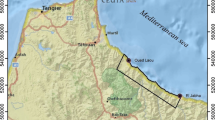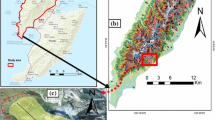Abstract
A landslide is one of the natural disasters that occur in Malaysia. In addition to the geological factor and the rain as triggering factor, topographic factors such as elevation, slope angle, slope aspect, and curvature are considered as the main causes of landslides. The study in this paper was conducted in three stages. The first stage involved the extraction of extra topographic factors. Previous landslide studies had identified only four of the topographic factors. However, eight new additional factors have also been identified in this study. They are general curvature, longitudinal curvature, tangential curvature, cross-section curvature, surface area, diagonal line length, surface roughness, and rugosity. At this stage, 13 factors were extracted from the digital elevation model. The second stage involved specifying the importance of each factor. The multilayer perceptron network and backpropagation algorithm were used to specify the weight of each factor. Results were verified using the receiver operating characteristics based on the area under the curve method in the third stage. The results indicated 76.07 % accuracy in predicting of landslides, with slope angle as the most important factor while the tangential curvature has the least importance.







Similar content being viewed by others
References
Aggarwal KK, Singh Y, Chandra P, Puri M (2005) Bayesian regularization in a neural network model to estimate lines of code using function points. J Comput Sci 1:505–509
Alkhasawneh MSh, Ngah UK, Tay LT, Nor ABMI (2012) Landslide susceptibility hazard mapping techniques review. J Appl Sci 12:802–808
Barletta M, Gisario A (2006) An application of neural network solutions to laser assisted paint stripping process of hybrid epoxy-polyester coatings on aluminum substrates. Surf Coat Technol 200(24):6678–6689
Bishop CM (1995) Neural networks for pattern recognition. Oxford University Press, Oxford
Chu TH, Tsai TH (1995) Comparison of accuracy and algorithms of slope and aspect measures from DEM. In: Proceedings of the GIS AM/FM ASIA’95, 21–24 Aug, Bangkok: I-1 to 11
Cybenko G (1989) Approximation by superposition’s of a sigmoidal function. Math Control Signals Syst 2(4):303–314
Ercanoglu M, Gokceoglu C (2004) Use of fuzzy relations to produce landslide susceptibility map of a landslide prone area (West Black Sea Region, Turkey). Eng Geol 75(3–4):229–250
Ermini L, Catani F, Casagli N (2005) Artificial neural networks applied to landslide susceptibility assessment. Geomorphology 66(1–4):327–343
Evans IS (1980) An integrated system of terrain analysis and slope mapping. Zeitschrift für geomorphologie Supplement B.d. 36:274–295
Fleming MD, Hoffer RM (1979) Computer aided analysis techniques for an operational system to map forest lands utilizing landsat MSS data. Master’s thesis and LARS information note 112277, Laboratory for Applications of Remote Sensing, Purdue University, West Lafayette, Indiana 47907, p 236
Funahashi KI (1989) On the approximate realization of continuous mappings by neural networks. Neural Netw 2(3):183–192
Huot E, Yahia H, Herlin I (2003) Landslide tracking with a curve evolution model driven by interferometric data. Geoscience and remote sensing symposium, 2003. IGARSS ‘03. Proceedings. 2003 IEEE international
Hutchinson JN (1995) Keynote paper: Landslide hazard assessment. In: Bell DH (ed) Landslides, Proceedings of the sixth International symposium on landslides, Feb, Christchurch, New Zealand, vol 3. A. A. Balkema, Rotterdam, The Netherlands, pp 1805–1841
Jones KH (1998) A comparison of algorithms used to compute hill slope as a property of the DEM. Comput Geosci 24(4):315–323
Lee S, Ryu J-H, Won JS, Park HJ (2004) Determination and application of the weights for landslide susceptibility mapping using an artificial neural network. Eng Geol 71(3–4):289–302
Lim KW, Tay LT, Lateh H (2011) Landslide hazard mapping of Penang Island using probabilistic methods and logistic regression. Imaging systems and techniques (IST), 2011 IEEE international conference
Oh HJ, Pradhan B (2011) Application of a neuro-fuzzy model to landslide-susceptibility mapping for shallow landslides in a tropical hilly area. Comput Geosci 37(9):1264–1276
Pang PK, Lea TT, Habibah L (2012) Landslide hazard mapping of Penang Island using decision tree model. International conference on systems and electronic engineering (ICSEE’2012) Dec 18–19, 2012 Phuket (Thailand)
Pradhan B, Lee S (2009) Landslide risk analysis using artificial neural network model focusing on different training sites. Int J Phys Sci 4(1):001–015
Pradhan B, Lee S (2010) Delineation of landslide hazard areas on Penang Island, Malaysia, by using frequency ratio, logistic regression, and artificial neural network models. Environ Earth Sci 60(5):1037–1054
Pradhan B, Lee S, Buchroithner MF (2010) A GIS-based back-propagation neural network model and its cross-application and validation for landslide susceptibility analyses. Comput Environ Urban Syst 34(3):216–235
Prodanovic D (2002) Terrain analysis—principles and applications. In: Wilson JP, Gallant JC (eds), Wiley, New York, 2000, 479 pp (index included), hbk, ISBN 0-471-32188-5. Urban Water 4(1):115. doi:10.1016/s1462-0758(01)00068-1
Ritter D (1987) A vector-based slope and aspect generation algorithm. Photogramm Eng Remote Sens 53(8):1109–1111 (53: 2544–2261)
Rumelhart DE, Mcclellandb JL, The PDP Research Group (1986) Parallel distributed processing: explorations in the microstructure of cognition. Foundations. MIT Press 1, Cambridge
Varnes DJ (1984) Landslide hazard zonation preview of principals and practice. Paris, UNESCO, International association of engineering geologists, commission on landslides and other mass movements on slopes, Natural hazards, vol 3. p 176
Weiyang Z (1999) Verification of the nonparametric characteristics of backpropagation neural networks for image classification. Geosci Remote Sens IEEE Trans 37(2):771–779
Wood JD (1996) The geomorphological characterization of digital elevation model. The geomorphological characterizations of digital elevation models Ph.D thesis, University of Leicester, UK, http://www.soi.city.ac.uk/~jwo/phd
Zevenbergen LW, Thorne CR (1987) Quantitative analysis of land surface topography. Earth Surf Process Landf 12:47–56
Zhou W (1999) Verifications of the nonparametric characteristics of backpropagation neural networks for image classification. IEEE Trans Geosci Remote Sens 38:771–779
Zhou Q, Liu X (2004) Analysis of errors of derived slope and aspect related to DEM data properties. Comput Geosci 30(4):369–378
Acknowledgments
The authors would like to thank the Minerals and Geosciences Department Malaysia and Department of Irrigation and Drainage Malaysia for the data used in this research. The authors also thank the Universiti Sains Malaysia for the facilities used this work.
Author information
Authors and Affiliations
Corresponding author
Rights and permissions
About this article
Cite this article
Alkhasawneh, M.S., Ngah, U.K., Tay, L.T. et al. Determination of importance for comprehensive topographic factors on landslide hazard mapping using artificial neural network. Environ Earth Sci 72, 787–799 (2014). https://doi.org/10.1007/s12665-013-3003-x
Received:
Accepted:
Published:
Issue Date:
DOI: https://doi.org/10.1007/s12665-013-3003-x




